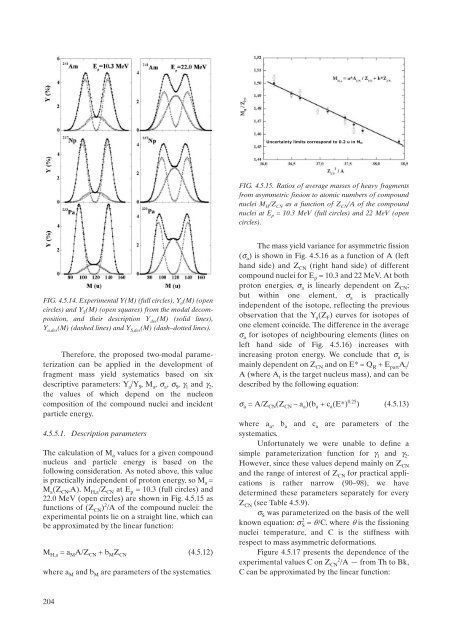Fission Product Yield Data for the Transmutation of Minor Actinide ...
Fission Product Yield Data for the Transmutation of Minor Actinide ...
Fission Product Yield Data for the Transmutation of Minor Actinide ...
You also want an ePaper? Increase the reach of your titles
YUMPU automatically turns print PDFs into web optimized ePapers that Google loves.
FIG. 4.5.14. Experimental Y(M) (full circles), Y a (M) (open<br />
circles) and Y S (M) (open squares) from <strong>the</strong> modal decomposition,<br />
and <strong>the</strong>ir description Y des(M) (solid lines),<br />
Y a,des(M) (dashed lines) and Y S,des(M) (dash–dotted lines).<br />
There<strong>for</strong>e, <strong>the</strong> proposed two-modal parameterization<br />
can be applied in <strong>the</strong> development <strong>of</strong><br />
fragment mass yield systematics based on six<br />
descriptive parameters: Y a /Y S , M a , s a , s S , g 1 and g 2 ,<br />
<strong>the</strong> values <strong>of</strong> which depend on <strong>the</strong> nucleon<br />
composition <strong>of</strong> <strong>the</strong> compound nuclei and incident<br />
particle energy.<br />
4.5.5.1. Description parameters<br />
The calculation <strong>of</strong> M a values <strong>for</strong> a given compound<br />
nucleus and particle energy is based on <strong>the</strong><br />
following consideration. As noted above, this value<br />
is practically independent <strong>of</strong> proton energy, so M a =<br />
M a (Z CN ,A). M H,a /Z CN at E p = 10.3 (full circles) and<br />
22.0 MeV (open circles) are shown in Fig. 4.5.15 as<br />
functions <strong>of</strong> (Z CN ) 2 /A <strong>of</strong> <strong>the</strong> compound nuclei: <strong>the</strong><br />
experimental points lie on a straight line, which can<br />
be approximated by <strong>the</strong> linear function:<br />
M H,a = a M A/Z CN + b M Z CN<br />
204<br />
(4.5.12)<br />
where a M and b M are parameters <strong>of</strong> <strong>the</strong> systematics.<br />
Uncertainty limits correspond to 0.2 u in M H<br />
FIG. 4.5.15. Ratios <strong>of</strong> average masses <strong>of</strong> heavy fragments<br />
from asymmetric fission to atomic numbers <strong>of</strong> compound<br />
nuclei M H/Z CN as a function <strong>of</strong> Z CN/A <strong>of</strong> <strong>the</strong> compound<br />
nuclei at E p = 10.3 MeV (full circles) and 22 MeV (open<br />
circles).<br />
The mass yield variance <strong>for</strong> asymmetric fission<br />
(s a) is shown in Fig. 4.5.16 as a function <strong>of</strong> A (left<br />
hand side) and Z CN (right hand side) <strong>of</strong> different<br />
compound nuclei <strong>for</strong> E p = 10.3 and 22 MeV. At both<br />
proton energies, s a is linearly dependent on Z CN;<br />
but within one element, s a is practically<br />
independent <strong>of</strong> <strong>the</strong> isotope, reflecting <strong>the</strong> previous<br />
observation that <strong>the</strong> Y a(Z F) curves <strong>for</strong> isotopes <strong>of</strong><br />
one element coincide. The difference in <strong>the</strong> average<br />
s a <strong>for</strong> isotopes <strong>of</strong> neighbouring elements (lines on<br />
left hand side <strong>of</strong> Fig. 4.5.16) increases with<br />
increasing proton energy. We conclude that s a is<br />
mainly dependent on Z CN and on E* = Q R + E part A t /<br />
A (where A t is <strong>the</strong> target nucleus mass), and can be<br />
described by <strong>the</strong> following equation:<br />
s a = A/Z CN(Z CN – a a)(b a + c a(E*) 0.25 ) (4.5.13)<br />
where a a , b a and c a are parameters <strong>of</strong> <strong>the</strong><br />
systematics.<br />
Un<strong>for</strong>tunately we were unable to define a<br />
simple parameterization function <strong>for</strong> g 1 and g 2 .<br />
However, since <strong>the</strong>se values depend mainly on Z CN<br />
and <strong>the</strong> range <strong>of</strong> interest <strong>of</strong> Z CN <strong>for</strong> practical applications<br />
is ra<strong>the</strong>r narrow (90–98), we have<br />
determined <strong>the</strong>se parameters separately <strong>for</strong> every<br />
Z CN (see Table 4.5.9).<br />
s S was parameterized on <strong>the</strong> basis <strong>of</strong> <strong>the</strong> well<br />
known equation: s 2 S = θ/C, where θ is <strong>the</strong> fissioning<br />
nuclei temperature, and C is <strong>the</strong> stiffness with<br />
respect to mass asymmetric de<strong>for</strong>mations.<br />
Figure 4.5.17 presents <strong>the</strong> dependence <strong>of</strong> <strong>the</strong><br />
experimental values C on Z CN 2 /A — from Th to Bk,<br />
C can be approximated by <strong>the</strong> linear function:

















